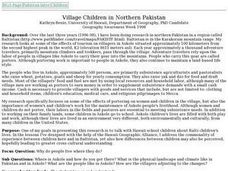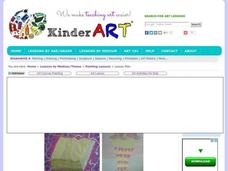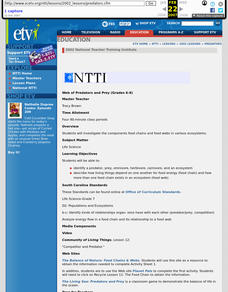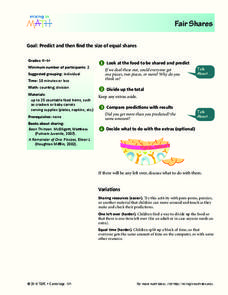Curated OER
Village Children in Northern Pakistan
Student use maps to answer geographic questions. They analyze Earth's surface by using a map to identify physical features that lead to different transportation routes. Student create a collage to show geographic insight into the topic...
Curated OER
Little Me in a Big World: Ants
First graders predict, observe and record strategies to overcome them using discussions, role play, and charts. Over a three or four day period, they examine obstacles that humans and insects encounter.
Kelly's Kindergarten
July Daily Activities
Concerned about your learners forgetting what they've learned during summer vacation? Use a learning guide to keep them busy every day of the week. With activities about writing, drawing, counting, adding, and time, your kids will be...
DiscoverE
Clean It Up
Water, water, everywhere, but not a drop to drink—until we clean it, of course! Scholars design a filtration device that removes pollutants from water. The goal is to have the water come out as clean as possible from the device. How...
Virginia Department of Education
The Effects of Heat and Acid on the Enzyme Catalase
How quickly do enzymatic reactions occur? Assist the class as they examine heat and pH change to determine the rate of chemical reactions using catalase as an enzyme. Watch them "glow" with excitement!
Curated OER
Drive-Thru Nutrition
High schoolers research fat and calorie content of various food items at 12 popular fast-food restaurants. They compare the foods and create a day's worth of healthy menus using food from those restaurants.
Curated OER
Stats on Reduced-Fat
Middle schoolers demonstrate an understanding of the Five-Number Summary and Box-Plots after analyzing data from nutrition labels, forming a hypothesis and supporting it. They decide if there is a significant difference between reduced...
Curated OER
NEXT YEAR'S SEEDS
1. Bring a pound or two of sunflower seeds in their shells to class, along with five or six small paper or Styrofoam cups and a bowl large enough to hold the seeds. Make several copies of the situation cards printed on the following...
Curated OER
Vegetable and Fruit Funny Face
Student creates a snack using peanut butter and crackers to make a funny face and discovers how different fruits and vegetables could be used to make a funny face in addition. They conclude that wise food choices are important and that...
Curated OER
Double or More
Students practice cooking by following recipe instructions. In this measuring lesson, students read food recipes and collect the materials needed to make one batch, then double the recipe to create twice as much food....
Curated OER
A Catering Idea
Students plan meals, create a shopping list, determine the cost of the meal, including incidentals such as labor and electricity used. In addition, they consider the cost of plates, table cloths, napkins, etc. Students prepare a meal and...
Curated OER
Sweet Stuff
Eighth graders examine the artwork of artist Wayne Thiebaud and create paintings based upon techniques learned in this lesson for the eighth grade art classroom. Emphasis is placed upon the use of various textures, visual balance, and...
Curated OER
Tables & Data
For this problem solving worksheet, 4th graders study the data found on a table involving the number of cans collected during a fund-raiser. Students utilize the concepts of addition and subtraction to solve 8 sentence word problems.
Curated OER
Web of Predators and Prey
Students investigate the components food chains and food webs in various ecosystems. They describe how living things depend on one another for food energy (food chain) and how more than one food chain exists in an ecosystem
Curated OER
Teaching Lewis and Clark: Tribal Cultures and Homelands
Students examine the attributes of the tribes that inhabited the Columbia River Basin. In this Lewis and Clark instructional activity, students participate in a classroom simulation that requires them to participate in a seasonal round,...
Curated OER
From Farm to Table
It's important for students to understand where our food comes from and the environmental implications of agriculture.
Curated OER
Immigration Unit
Third graders develop an appreciate for the various cultures that are present in their local community. Through reading and research, they explain how various culture came to live in their area. At the conclusion of the unit, 3rd...
Curated OER
Testing for Life
Students test for organic molecules to determine if a solution contains once living molecules. In this characteristics of life lesson, students test common liquids for the presence of organic molecules, including starch, protein, and...
Curated OER
Read That Label!
Students explore reading nutritional labels and making good food choices through simulation. They prepare and design a label for a product. In addition, they create packaging and advertising to ensure access to the population.
Curated OER
Pond Theme Unit
In this pond theme instructional activity students research facts on pond life. Students complete comprehension questions, crosswords, word search, and math puzzles. Students write a short report.
Curated OER
Fair Shares
Young scholars investigate division by sharing food items with their classmates. In this division lesson, students are given a food item which they must equally share among the class using division. Young scholars predict how...
Curated OER
Organic Feud
Young scholars examine possible pesticide exposure in their fruit and vegetable consumption. They compile fact sheets exploring various organic food issues and interview their parents about the food choices they make for their Students.
Curated OER
Breaking News English: Green Invitation
For this cardboard box solar cooker worksheet, students read the article, answer true and false questions, complete synonym matching, complete phrase matching, complete a gap fill, answer short answer questions, answer discussion...
Curated OER
Composting
In this recognizing items that can be composted activity, students identify organic items that can be composted, write items that can be composted for each of the letters in the word compost, and make a list of vegetables and fruits....























